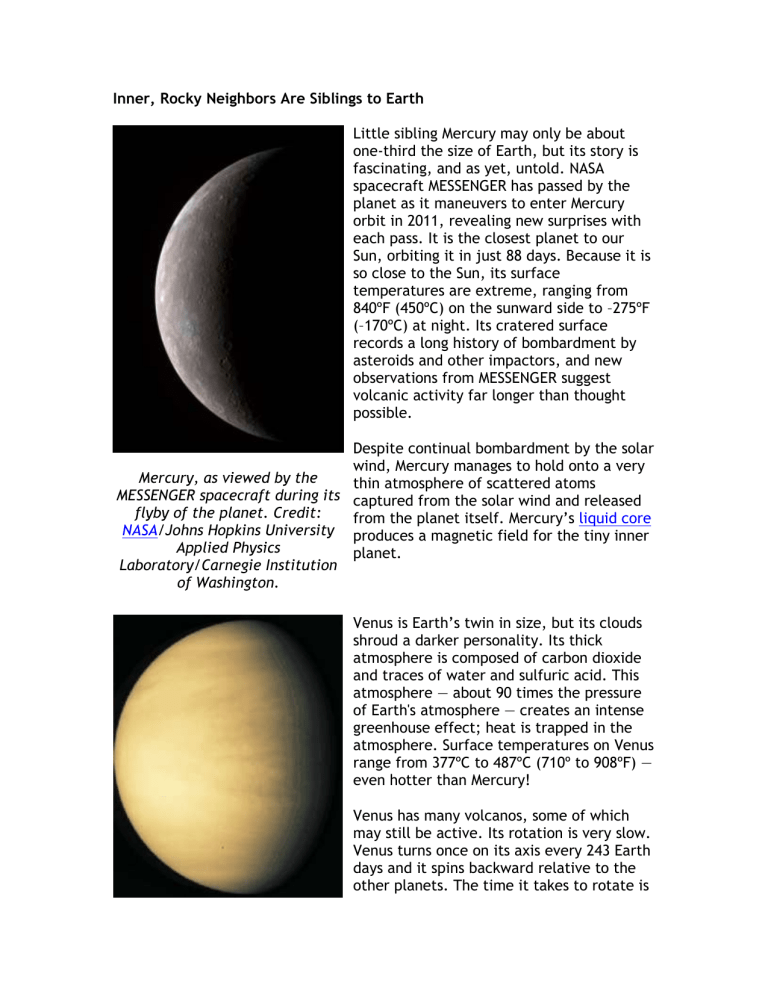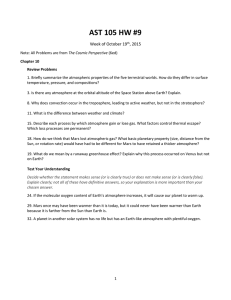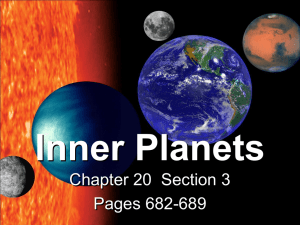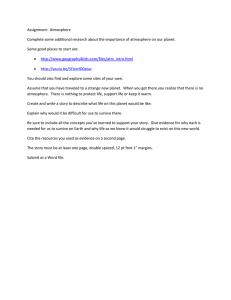Inner, Rocky Neighbors Are Siblings to Earth

Inner, Rocky Neighbors Are Siblings to Earth
Little sibling Mercury may only be about one-third the size of Earth, but its story is fascinating, and as yet, untold. NASA spacecraft MESSENGER has passed by the planet as it maneuvers to enter Mercury orbit in 2011, revealing new surprises with each pass. It is the closest planet to our
Sun, orbiting it in just 88 days. Because it is so close to the Sun, its surface temperatures are extreme, ranging from
840ºF (450ºC) on the sunward side to –275ºF
(–170ºC) at night. Its cratered surface records a long history of bombardment by asteroids and other impactors, and new observations from MESSENGER suggest volcanic activity far longer than thought possible.
Mercury, as viewed by the
MESSENGER spacecraft during its flyby of the planet. Credit:
NASA /Johns Hopkins University
Applied Physics
Laboratory/Carnegie Institution
of Washington.
Despite continual bombardment by the solar wind, Mercury manages to hold onto a very thin atmosphere of scattered atoms captured from the solar wind and released from the planet itself. Mercury’s planet. liquid core produces a magnetic field for the tiny inner
Venus is Earth’s twin in size, but its clouds shroud a darker personality. Its thick atmosphere is composed of carbon dioxide and traces of water and sulfuric acid. This atmosphere — about 90 times the pressure of Earth's atmosphere — creates an intense greenhouse effect; heat is trapped in the atmosphere. Surface temperatures on Venus range from 377ºC to 487ºC (710º to 908ºF) — even hotter than Mercury!
Venus has many volcanos, some of which may still be active. Its rotation is very slow.
Venus turns once on its axis every 243 Earth days and it spins backward relative to the other planets. The time it takes to rotate is
Credit: NASA/Calvin J. Hamilton.
Venus, as viewed by the Galileo spacecraft. actually longer than the time it takes to orbit the Sun.
Mars takes after Earth in many ways. It is only about half the size of Earth, but its similar geology, thin atmosphere, and the presence of water make it seem more like home. Its day is almost as long as Earth's, but it takes about two Earth years to orbit the Sun. Mars is tilted on its axis, so it experiences seasons.
Hubble Space Telescope image of
Mars as the planet made its closest approach to Earth in
August 2003.
Credit: NASA.
Mars has the tallest volcano in our solar system —about 22 kilometers tall (almost 14 miles high). [Compare this to Hawaii's
Mauna Loa at 9 kilometers (5.5 miles) tall measured from the sea floor.] Some of the volcanos on Mars have been recently active.
However, its surface temperatures are cold — –125º to –23ºF (–87º to –5ºC) — and the planet is very dry. The atmosphere is thin and composed mostly of carbon dioxide.
There is no liquid water present at the surface, but robotic explorers have discovered frozen water in the subsurface and in its polar ice caps, which are comprised of frozen carbon dioxide and water ice. There is evidence that Mars had flowing water and oceans at its surface during its early history, perhaps until about three and a half billion years ago.






